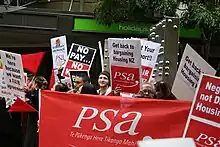New Zealand Public Service Association | |
Te Pūkenga Here Tikanga Mahi | |
 | |
| Formation | 31 October 1913[1] |
|---|---|
| Type | Trade union |
| Headquarters | Wellington |
| Location | |
Membership (2022) | 80,000[2] |
President | Benedict Ferguson[3] |
| Affiliations | NZCTU, IPANZ, Allied Health Aotearoa New Zealand, Tax Justice Aotearoa, PSI, UNI Global Union[4] |
| Funding | Member subscription fees[5] |
| Website | www |
The Public Service Association (Māori: Te Pūkenga Here Tikanga Mahi), or PSA, is a democratic trade union with over 80,000 workers in the New Zealand public sector. The stated aim of the PSA is to advance the principles of Te Tiriti o Waitangi in the working lives of the union's members.[6]
The PSA is affiliated with the New Zealand Council of Trade Unions and Public Services International but is forbidden, by its own rules, from affiliating with political parties or organisations.[7]: Rule 8(2)
History
The New Zealand Public Service Association officially dates from 31 October 1913.[1]
Public servants were poorly paid and were often forced to take pay cuts when the economy stalled. In 1931, for example, all public servant salaries were cut by 10%. It was only loans from the Public Service Investment Society, set up by the PSA in 1928, that prevented many of them from falling into loan sharks. An overcrowded Wellington department was described by the PSA as "a compromise between a hot-house and a tin shed erected by amateur carpenters". With a change of government in 1936, a five-day working week for public servants was introduced.
In 1950, its membership was nearly 30,000. A major focus of the 1950s was discrimination against women. The PSA also passed the Government Service Equal Pay Act.

In 1979, in response to a notice of strike action by electricity workers, the government introduced the Public Service Association Withdrawal of Recognition Bill. The bill would have given the government the power to seize all the assets of the union and vest them in the public trustee. In the face of mass protests and a PSA offer to submit the dispute to mediation, the government backed down and withdrew the bill. In 1987, the government introduced the State Sector Bill. PSA members held massive protest meetings and a national strike in 1988.
In the early 1990s, the Employment Contracts Act removed unions as legal entities, with restricted rights.
In the late 1990s, the PSA worked with the Government and State Services Commission to reassess and rebuild the public service. It developed the Partnership for Quality.
In 2000, the first Quality for Partnership Agreement was signed by the PSA and the government. Though the current government has chosen not to enter into a formal partnership with the PSA. In 2006, the union negotiated national pay rates for occupational groups in the health sector.
In 2010, the union negotiated a collective employment agreement for its 6,000 local government members in Auckland when eight councils and a large number of council-controlled organisations were amalgamated into a single Auckland council.
Governance
Workplaces and sectors
Each PSA member in a workplace pays a membership subscription fee.[8] Those fees provide the vast majority of the union's income.[5]
Workplaces are grouped into five sectors:
- Public Service (Rātonga mahi ā te Kāwanatanga)
- District Health Boards (Pōari Hauora ā Rohe)
- State Sector (Rāngai Tūmatanui)
- Local Government (Kāwanatanga-ā-Rohe)
- Community Public Services (Rātonga Mahi ā Hāpori)[7]: Part 6
Groups
Members may also belong to national groups, and the following groups are represented on the union's committees:
Meetings and committees
Each workplace has an annual meeting.[7]: Part 4 The delegates form a workplace committee and then elect a convenor. Delegate committees have positions for Te Rūnanga o Ngā Toa Āwhina and Pasefika Network.
Having consulted their members, the delegates in a sector elect their peers to the sector committee. The delegates on each sector committee elect two co-convenors, at least one of whom must be a woman, and the committee includes delegates from Te Rūnanga o Ngā Toa Āwhina, Pasefika Network and PSA Youth.
Every two years, a national delegates' congress is held.[7]: Part 10 The current president, Benedict Ferguson, was elected in 2020.[3]
In between congresses, the executive board sets and oversees the implementation of policy.[7]: Part 8 The board includes the president and leaders of Te Rūnanga o Ngā Toa Āwhina, Pasefika Network and PSA Youth.
Notes
- 1 2 Roth 1987, p. 35.
- ↑ "About the PSA". PSA. n.d. Retrieved 5 September 2022.
- 1 2 "Benedict Ferguson elected new PSA President". PSA. 18 November 2020. Retrieved 7 September 2022.
- ↑ "Affiliations". PSA. n.d. Retrieved 15 September 2022.
- 1 2 "Annual Report 2020-2021" (PDF). PSA. n.d. p. 16. Retrieved 17 September 2022.
- ↑ "PSA Strategic Goals". PSA. n.d. Retrieved 5 September 2022.
- 1 2 3 4 5 6 National Delegates' Congress (2021). "Rules, Regulations & Sector Procedures". PSA. Retrieved 6 October 2022.
- ↑ "Join the PSA". PSA. n.d. Retrieved 17 September 2022.
- ↑ "Networks". PSA. n.d. Retrieved 11 September 2022.
References
Books
- No Easy Victory: Towards equal pay for women in the government service, 1890–1960 by Margaret Corner
- White-collar Radical:Dan Long and the rise of the white-collar unions by Mark Derby